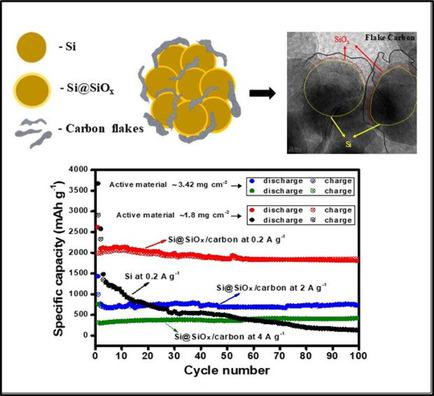当前位置:
X-MOL 学术
›
ChemElectroChem
›
论文详情
Our official English website, www.x-mol.net, welcomes your feedback! (Note: you will need to create a separate account there.)
Si/SiOx Nanoparticles Embedded in a Conductive and Durable Carbon Nanoflake Matrix as an Efficient Anode for Lithium‐Ion Batteries
ChemElectroChem ( IF 4 ) Pub Date : 2020-09-10 , DOI: 10.1002/celc.202001130 Arunakumari Nulu 1 , Venugopal Nulu 2 , Keun Yong Sohn 3
ChemElectroChem ( IF 4 ) Pub Date : 2020-09-10 , DOI: 10.1002/celc.202001130 Arunakumari Nulu 1 , Venugopal Nulu 2 , Keun Yong Sohn 3
Affiliation

|
In this study, a route to synthesize a Si@SiOx/carbon nanoflake nanocomposite is proposed using ecological and polar solvent‐soluble ethyl cellulose as a promising new carbon source for obtaining silicon composites. Equal proportions of ethylcellulose and commercial nanosilicon powders are used to prepare the silicon/organic hybrid through an in situ chemical process, and the subsequent carbonization affords the Si@SiOx/C composite. The SiOx layer is partially formed using the employed method and air drying processes. As an anode electrode for lithium‐ion batteries (LIBs), the composite provides excellent reversible capacity (1830 mAh g−1 at 200 mA g−1 after 60 cycles) with 92 % capacity retention and superior rate performance (1464 mAh g−1 at 3.2 A g−1). The electrode with a high mass loading of 3.42 mg cm−2 delivered discharge capacities of 753 and 387 mAh g−1 at high current densities of 2 A g−1 and 4 A g−1, respectively. These results show that the coupling of silicon nanoparticles with an oxide layer and a conductive carbon framework is an effective design to retain the inherent properties of the silicon‐based anode, exhibiting its potential for use as a low‐cost anode for practical applications.
中文翻译:

Si/SiOx Nanoparticles Embedded in a Conductive and Durable Carbon Nanoflake Matrix as an Efficient Anode for Lithium‐Ion Batteries
In this study, a route to synthesize a Si@SiOx/carbon nanoflake nanocomposite is proposed using ecological and polar solvent‐soluble ethyl cellulose as a promising new carbon source for obtaining silicon composites. Equal proportions of ethylcellulose and commercial nanosilicon powders are used to prepare the silicon/organic hybrid through an in situ chemical process, and the subsequent carbonization affords the Si@SiOx/C composite. The SiOx layer is partially formed using the employed method and air drying processes. As an anode electrode for lithium‐ion batteries (LIBs), the composite provides excellent reversible capacity (1830 mAh g−1 at 200 mA g−1 after 60 cycles) with 92 % capacity retention and superior rate performance (1464 mAh g−1 at 3.2 A g−1). The electrode with a high mass loading of 3.42 mg cm−2 delivered discharge capacities of 753 and 387 mAh g−1 at high current densities of 2 A g−1 and 4 A g−1, respectively. These results show that the coupling of silicon nanoparticles with an oxide layer and a conductive carbon framework is an effective design to retain the inherent properties of the silicon‐based anode, exhibiting its potential for use as a low‐cost anode for practical applications.
更新日期:2020-10-13
中文翻译:

Si/SiOx Nanoparticles Embedded in a Conductive and Durable Carbon Nanoflake Matrix as an Efficient Anode for Lithium‐Ion Batteries
In this study, a route to synthesize a Si@SiOx/carbon nanoflake nanocomposite is proposed using ecological and polar solvent‐soluble ethyl cellulose as a promising new carbon source for obtaining silicon composites. Equal proportions of ethylcellulose and commercial nanosilicon powders are used to prepare the silicon/organic hybrid through an in situ chemical process, and the subsequent carbonization affords the Si@SiOx/C composite. The SiOx layer is partially formed using the employed method and air drying processes. As an anode electrode for lithium‐ion batteries (LIBs), the composite provides excellent reversible capacity (1830 mAh g−1 at 200 mA g−1 after 60 cycles) with 92 % capacity retention and superior rate performance (1464 mAh g−1 at 3.2 A g−1). The electrode with a high mass loading of 3.42 mg cm−2 delivered discharge capacities of 753 and 387 mAh g−1 at high current densities of 2 A g−1 and 4 A g−1, respectively. These results show that the coupling of silicon nanoparticles with an oxide layer and a conductive carbon framework is an effective design to retain the inherent properties of the silicon‐based anode, exhibiting its potential for use as a low‐cost anode for practical applications.



























 京公网安备 11010802027423号
京公网安备 11010802027423号